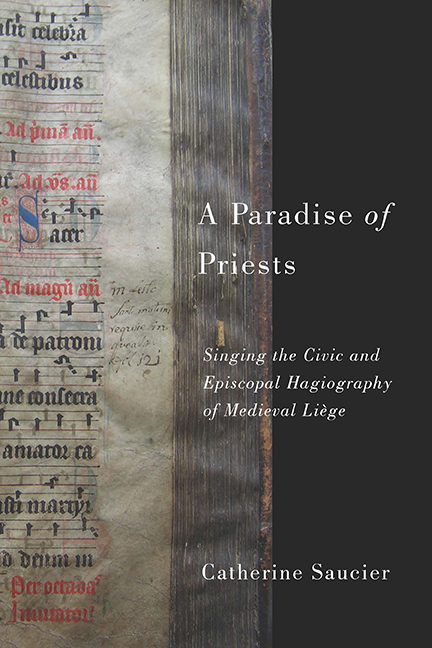Book contents
- Frontmatter
- Dedication
- Contents
- List of Illustrations
- Acknowledgments
- Abbreviations
- Note on Editorial Conventions
- Introduction: The Sound of Civic Sanctity in the Priestly Paradise of Liège
- 1 Martyred Bishops and Civic Origins: Promoting the Clerical City
- 2 The Intersecting Cults of Saints Theodard and Lambert: Validating Bishops as Martyrs
- 3 The Civic Cult of Saint Hubert: Venerating Bishops as Founders
- 4 Clerical Concord, Disharmony, and Polyphony: Commemorating Bishop Notger's City
- 5 Military Triumph, Civic Destruction, and the Changing Face of Saint Lambert's Relics: Invoking the Defensor Patriae
- Conclusion: Hearing Civic Sanctity
- Appendix: Service Books Preserving the Medieval Chant Repertory Sung in the City of Liège
- Notes
- Bibliography
- Index
Conclusion: Hearing Civic Sanctity
Published online by Cambridge University Press: 15 March 2018
- Frontmatter
- Dedication
- Contents
- List of Illustrations
- Acknowledgments
- Abbreviations
- Note on Editorial Conventions
- Introduction: The Sound of Civic Sanctity in the Priestly Paradise of Liège
- 1 Martyred Bishops and Civic Origins: Promoting the Clerical City
- 2 The Intersecting Cults of Saints Theodard and Lambert: Validating Bishops as Martyrs
- 3 The Civic Cult of Saint Hubert: Venerating Bishops as Founders
- 4 Clerical Concord, Disharmony, and Polyphony: Commemorating Bishop Notger's City
- 5 Military Triumph, Civic Destruction, and the Changing Face of Saint Lambert's Relics: Invoking the Defensor Patriae
- Conclusion: Hearing Civic Sanctity
- Appendix: Service Books Preserving the Medieval Chant Repertory Sung in the City of Liège
- Notes
- Bibliography
- Index
Summary
We will conclude our study of the civic sanctification of medieval Liège in the way we began—by listening to Laetare et lauda. In many ways, this plainchant antiphon constitutes the liturgical equivalent of a theme song, repeatedly voicing a familiar idea and melody at different times, in different contexts, and by different means. Laetare et lauda gave musical voice to the ideal of civic merit first infused into Saint Lambert's vita by Sigebert of Gembloux, the late eleventh-century monk who wrote for prominent members of the episcopal entourage at precisely the time that the bishop and his all-powerful cathedral chapter sought to assert their supremacy throughout the diocese. Hailing both Liège and Lambert with anaphoric poetry and recurring melodic motives, this chant audibly conflates the city's identity with that of its saint. Through its verbal ties to Canon Nicholas's twelfth-century embellishments to Saint Lambert's life and legend, the chant may have equally recalled the renewal of Lambert's cult in the city “crowned” by his triumphant reappropriation of church property at the Battle of Bouillon. Additionally, the antiphon addressed clerical concerns for the legitimacy of Lambert's lofty martyrial status by invoking the priestly martyr as a “lover of chastity,” alluding to Lambert's disapproval of adultery— the legendary cause of his martyrdom. By singing Laetare et lauda, local clerics could thus celebrate both the preeminence of their city over other urban communities and the prestige of their episcopal martyr over other bishops.
Yet this communal expression of saintly–civic pride would acquire a more tangible and individualized association in later eras. When cantor Henry of Palude intoned Laetare et lauda in 1489, the entire clerical community renewed its faith in the merits of the recently destroyed city by beholding the crude features of Lambert's nude skull. Inspired by this vivid relic display, the chant text would become permanently associated with Saint Lambert's reliquary bust in the early sixteenth century. Just as the bust visualized the individual features of Lambert's face, the inscription accompanying the image of its most enthusiastic donor, Bishop Erard de la Marck, transformed the chant's communal plea into a personal prayer. While the singers performing this chant continued to praise Liège as a worthy civic counterpart to its saintly martyr, the donor's silent prayer summoned Lambert's lasting oversight of his personal well-being and the clerical reforms he undertook.
- Type
- Chapter
- Information
- A Paradise of PriestsSinging the Civic and Episcopal Hagiography of Medieval Liège, pp. 202 - 204Publisher: Boydell & BrewerPrint publication year: 2014



